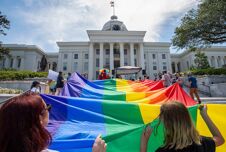As the rebels of the Stonewall era enter their 60s and prepare for the sunshine years, the movement they forged is helping shape new ways of aging for the LGBT community.
More than 20 LGBT-focused retirement communities – homes, apartment buildings or resorts – are in various stages of development in the United States, some as private enterprises, some as public-private partnerships. Several communities already exist, catering to a people who busted open closet doors and don’t want to retreat to those closets in retirement.
But new housing cannot nearly meet the needs of LGBT seniors. For instance, a new affordable housing project underway in San Francisco will provide only 110 apartments and there are an estimated 25,000 LGBT seniors in the city already.



A National Gay and Lesbian Task Force study in 2010 estimated there were 3 million LGBT Americans over the age of 65 and that number will double by 2030.
Never Miss a Beat
Subscribe to our newsletter to stay ahead of the latest LGBTQ+ political news and insights.
The Cream City Foundation, which serves as a catalyst for social change on behalf of LGBT communities in Southeastern Wisconsin, published the groundbreaking “Wisconsin’s Elder Readiness: A Lesbian, Gay, Bisexual and Transgender Lens” in 2011.
The report estimated that about 53,000 to 106,000 older adults in Wisconsin are LGBT. The report also said Wisconsin’s population is aging rapidly – by 2020 there will be more people 60 years and older than children enrolled in K-12 schools in the state.
“And we’re talking about an increasingly diverse older adult population,” said Serena Worthington, director of community advocacy and capacity-building for SAGE. Services and Advocacy for GLBT Elders is a national organization with 23 affiliates in 16 states, including a popular group in Milwaukee that Worthington said is becoming part of the Milwaukee LGBT Community Center.
Worthington was working in art therapy at a nursing home in Chicago when she began taking a specific interest in LGBT aging issues. Eventually she went to work for the Center on Halsted, Chicago’s LGBT community center on Halsted Street in the heavily gay Lakeview neighborhood, and then for SAGE.
“If you get a group of seniors together, they’ll talk about the same thing, the same concerns,” Worthington said. Regardless of gender identity or sexual orientation, older Americans will talk about health care, transportation, housing and being alone.
LGBT people, Worthington added, will also talk “about acceptance and being able to be who they are where they live.”
These are valid concerns for a population that knows about isolation and discrimination.
Today’s LGBT seniors “came of age in an era when it was illegal to be gay. …This is a whole group of people whose formative years are shaped by this stigma, this rejection,” Worthington said.
In Milwaukee, different groups have examined aging issues and assessed needs in the LGBT community. There’s general agreement that providing access to affordable – and welcoming – housing must be a priority.
“There’s certainly a need, as we well know,” said Paul Fairchild, president and CEO of Cream City Foundation.
Fairchild said community leaders have had some discussions with representatives from the U.S. Department of Housing and Urban Development. But, he added, “We have a lot of work to do.”
Fairchild played an early, pivotal role in developing an LGBT aging program in Chicago in the 1990s and acknowledged that establishing affordable housing can be a lengthy effort. Although construction is set to begin this year on the senior housing project in Chicago’s Boystown, Fairchild said, “We started talking about that housing issue all those years ago.”
A ‘vulnerable population’
Contrary to a public perception, study after study shows that LGBT people are not disproportionately affluent. Discrimination has limited or ended careers, including military service, and denied same-sex couples many benefits others receive to prepare for their sunshine years.
Studies also show that LGBT people are twice as likely to enter old age as singles; less likely to have relatives who will care for them in old age; less likely to access health care, housing or social services – or, when they do access such services, more likely to say the experience is stressful or demeaning.
“We’re talking about a population that is pretty vulnerable,” said Worthington.
Older LGBT Americans in partnerships may find themselves unwelcome in a traditional retirement community or find that, because they are not legally married, they can’t share a room at a nursing home.
Some of these trends are likely to shift as a result of changing attitudes about LGBT people and transformative political reforms, especially the potential overturning of the U.S. Defense of Marriage Act as early as this summer. But what won’t change is the need for adequate services for a booming LGBT senior population.
A study by the National Senior Citizens Law Center and Lambda Legal found that many LGBT seniors in traditional retirement settings feel pressured to return to the closet. But, in some communities, there are nonprofits working with government agencies to create affordable housing so seniors can remain in their neighborhoods, in some cases the vibrant LGBT-centric neighborhoods they helped establish.
Triangle Square Hollywood is a four-story retirement community in Los Angeles that’s operated by the nonprofit Gay and Lesbian Elder Housing and provides housing to seniors who are 62 and older and earning 60 percent or less of the area’s median income. Triangle, built as a result of a public-private-nonprofit partnership, features more than 100 apartments, as well as an activity center, a pool and social service programs.
In Philadelphia, construction is underway on the John C. Anderson Apartments, named for a gay city councilman instrumental in the passage of Philadelphia’s gay rights bill in 1982 and a mentor to Philadelphia Mayor Michael Nutter. The 56-apartment affordable housing project in the city’s Gayborhood involves the William Way LGBT Community Center, the city, the Dr. Magnus Hirschfeld Fund and Penrose Properties. Construction could be finished this year.
In Denver, SAGE of the Rockies is working with other groups on exploring the creation of a retirement community in the heavily gay Capitol Hill neighborhood.
In Minneapolis, Spirit on the Lake Housing Co-op is a proposed 46-unit project for those earning less than half the area median income. The project involves the Spirit of the Lakes UCC Church and a community housing development group. The building may open as early as September.
In Chicago, the Center on Halsted and the Heartland Alliance, Inc. are working with the city and local housing authority to convert an empty police station at Addison Avenue and Halsted Street into a mixed-use building that contains commercial space and 70 apartments for low- and moderate-income seniors. Construction could be completed by next spring.
In San Francisco, the nonprofit Openhouse has city and county support, as well as the involvement of a private developer, for the development of 110 apartments for low-income seniors at 55 Laguna St., part of a larger multi-family development at the property. Construction is expected to start in late 2014.
“The 55 Laguna development addresses a critical need for LGBT seniors, who face enormous challenges in finding welcoming and affordable housing,” said Openhouse’s Seth Kilbourn. “For decades, thousands of LGBT people have come to San Francisco to find personal freedom and acceptance. As older adults with increasing needs, the pioneers of this migration are being forced back into the closet in order to receive the quality care and housing they need. They are being forced to relocate and leave dear friends behind. 55 Laguna will be a critical community resource to help LGBT seniors age with dignity and grace in the city they call home.”
Elsewhere, there’s a focus on market-rate LGBT-centric retirement communities, although some have struggled to survive the recession, foreclosure and bankruptcy.
In New Mexico, RainbowVision Santa Fe consists of a restaurant, a lounge with cabaret entertainment, the Billie Jean King Spa and Fitness Center, as well as more than 100 condominiums and 26 assisted-living apartments.
In Santa Rosa, Calif., the luxurious Fountaingrove Lodge LGBT Retirement Community features a pool, pet park, orchard, wine cave, art studio, bistro and cocktail lounge, as well as apartments and bungalows.
Outside Palm Springs, Calif., a massive proposed market-rate project is to be called Boom. The $250-million “urban village” is in the early planning stages.
In addition to creating LGBT-specific senior housing, aging specialists are working on alternatives – homesharing programs, building partnerships with housing authorities and continuing to train people at senior centers, nursing homes and assisted-living facilities to help make LGBT seniors feel more comfortable in more settings.
Perhaps it is not as exciting as seeing the groundbreaking on a new building, but this work will lead to “huge structural change,” Worthington said.













